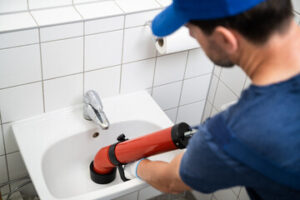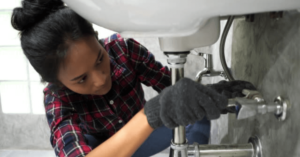A drain or sewer line that’s leaking or clogged can be an emergency situation. If it’s left untreated, it can cause severe water damage to your home or business.

Detecting signs of drain problems is important, so you can address them promptly. Fortunately, modern drain repair methods minimize property disruption and costs. For professional help, contact Drain Repair Near Me.
You may not think about it often, but your home would not function without the network of buried pipes that carry water, waste and sewer. As the years pass, these pipes can develop issues that require replacement. In the past, this task was typically accomplished using excavation-based techniques. This involved digging trenches across your property to expose and remove the old pipe. This process is very labor-intensive and expensive, but a new technology has been developed that makes it possible to replace underground pipes with minimal disturbance to your property.
This innovative technique is called pipe bursting and is ideal for replacing damaged orangeburg pipes. It is also a good option for rehabilitating old pipe lines that run through landscaped areas where conventional excavation damage would be unacceptable.
The first step in this method is to define the entry point and the receiving pit. A machine is set up in the pit to pull the expander head and the new pipe into place. The head will be guided through the clogged or damaged pipe and burst the original pipe into small pieces, leaving space for the new line to be pulled in. The process is less invasive than traditional excavation methods, and it can be completed in a fraction of the time.
Aside from removing damaged or broken pipes, pipe bursting can be used to increase the carrying capacity of existing pipelines. This is particularly useful when it comes to aging or undersized sewer lines that have been overburdened by excessive debris. It is also ideal for repairing damaged lines that have been cracked or corroded by tree roots.
Unlike other methods of drain repair, pipe bursting is less expensive and quicker than excavation-based repairs. This is because it does not require the use of heavy equipment to dig large holes in the ground. It also does not disturb the surrounding environment as much as other methods. The resulting clean-up and restoration process is also far quicker than conventional excavation. This is why the trenchless pipe bursting method has become increasingly popular with homeowners.
Hard water
Water is a very good solvent and is able to pick up a variety of impurities as it passes through soil, rock, and other natural barriers. This includes minerals such as calcium and magnesium, which give it its hardness. Although hard water is safe for human consumption, it can have a negative impact on household plumbing and appliances. Fortunately, there are several practical solutions to mitigate the adverse effects of hard water.
One of the most common problems associated with hard water is the formation of soap scum, which clings to surfaces in sinks, tubs, and showers. This is caused when the hardness minerals in the water combine with soap to form a sticky, film-like substance that cannot be rinsed away. This build-up not only creates an unsightly mess but also interferes with the normal functioning of your home’s plumbing system.
Another problem associated with hard water is the slow flow of water through the pipes. When mineral deposits and other debris build up, they restrict the flow of water and may even cause a complete clog. This can lead to low water pressure and reduce the efficiency of appliances.
Aside from causing blockages, the hardness of water can also affect your health. This is because hard water can have a negative impact on your skin, hair, and nails. It can also shorten the lifespan of clothes and damage the functionality of appliances. It can even make your house less energy efficient, resulting in higher energy bills.
The best way to avoid the problems of hard water is to prevent it from entering your home. You can do this by testing your local water supply. Most municipalities and public water supplies offer free water tests that can tell you what’s in your drinking water. You can also buy a kit at your local hardware store or online retailer.
The primary cause of hard-water clogged drains is the build-up of calcium and other minerals in your home’s plumbing pipes. To keep these minerals from building up, you should use a descaler or install a water softener. You should also regularly inspect your plumbing system and drains for any signs of clogging or damage. This will help you catch and repair the problem before it gets out of hand.
Pipe lining
Pipe lining is a modern way to repair old, damaged pipes without removing them. The process involves a special epoxy resin that can be injected into the pipe and harden to form a strong, durable new pipe. The resulting pipe is resistant to root penetration and can withstand high water pressure. It is also eco-friendly, as the production of the epoxy does not create carbon emissions. However, it is not suitable for every drain problem, and it should be performed by a professional plumber.
Known as cured-in-place pipe, or CIPP lining, it is one of the most common trenchless methods for repairing your sewer pipes. It is used to prevent further damage from leaks, cracks, or intruding roots, and can increase the lifespan of your pipes by up to 100 years. The CIPP lining process starts by clearing the existing pipes of obstructions and cleaning them thoroughly. Once the pipes are clean, they will then mix a two-part epoxy resin that includes a base and a hardener. This is then poured into a structural fabric liner that has been cut to the size of the pipe and then inserted into the damaged pipes. Once the liners have been inserted, they are then exposed to heat to cure them.
Although this method of repairing your pipes is less invasive than the traditional pipe replacement, it is not without its drawbacks. A recent investigation by USA TODAY found that styrene resin, the primary ingredient in many cured-in-place lining products, can cause cancer and respiratory problems. Several people reported that they developed ringing in their ears and other health issues after being near a CIPP installation.
In some cases, you may need to have your entire plumbing system replaced. This can be more expensive than pipe relining, but it can be worth the investment if your current pipes are in poor condition or need to be replaced. It’s important to consider both the costs and benefits of each option before deciding which one is right for you.
A more advanced trenchless plumbing technique is called pipe bursting. This method is usually employed when the piping in your home or business is too damaged for pipe relining. This technique involves pushing the old piping outward into the soil, which is then filled with new piping. It is an ideal solution for replacing older, corroded, or leaky pipes. It is also used to extend the diameter of buried drainage pipes.
Repairing a clogged drain
Clogged drains are a sure sign that it’s time to call in a professional plumber. If left untreated, a clogged drain can cause wastewater to back up into your home, leading to a variety of problems such as bad smells and even structural damage. While there are many ways to repair a clogged drain, the severity of the problem dictates whether you need a simple fix or a more comprehensive solution.
The first step in repairing a clogged drain is to try to remove the blockage with your hands, if possible. Shower and bathtub drains can often have hair or other debris that gathers under the drain screen. A flashlight can help you identify potential clogs in these areas, and you can use a pair of pliers or a wire coat hanger to manually extract the obstruction. After removing the clog, you can run hot water down the drain to flush away any remaining particles.
If manual methods fail to work, you can try using a drain snake or auger to dislodge the clog. These tools can be purchased at most hardware stores, and they range from handheld options to those that attach to a drill. Begin by removing the P-trap, which is a horizontal pipe that connects your drainage system to the wall pipe. Feed your tool down the wall pipe until you feel resistance, and then pull it up to break up or remove the clog material. Once the clog is gone, you can use a drain plunger or a hand-held drain auger to clear out any remaining debris.
More severe clogs may require more extensive drain repair techniques, such as pipe excavation or a drain line replacement. This type of repair involves digging a trench to reach the damaged area, but professional engineers will ensure that the work is done safely and with minimal disruption to your property.
If you notice any signs of a drain pipe problem, including slow drainage and foul smells, it’s best to call in a professional plumber to avoid expensive repairs. A qualified plumber can assess the full extent of the damage and recommend the right drain repair method for your situation.
